instrument cluster SSANGYONG KORANDO 2012 Owner's Guide
[x] Cancel search | Manufacturer: SSANGYONG, Model Year: 2012, Model line: KORANDO, Model: SSANGYONG KORANDO 2012Pages: 1082, PDF Size: 96.1 MB
Page 712 of 1082

05-498010-01
Pin No.Message
Operating condition
Domestic Export
Winter mode
(SVC class)
Tire alignment
(applies to
vehicle with
EPS)
CAN scan(This message goes off when all the CAN signal inputs
are normal)
The message "SET WINTER MODE" is displayed
on the LCD display when the winter mode is
activated. The message "RELEASE WINTER
MODE" is displayed when it is deactivated.
The message "WINTER MODE" is displayed when
the vehicle starts off with the winter mode set. -
-
This message helps the driver to predict the driving
direction since the tire alignment is displayed on the
instrument cluster.
The images on the left show that the tires are
aligned to the left. When the tires are aligned to the
right, the image is symmetrical vertically.
Tire alignment is displayed between level 0 and
level 5 depending on the alignment degree when
the ignition switch is turned to "ON" position from
"OFF" position with the shift lever in "P" or "N"
position. While the images up to level 2 comes on
for 5 seconds, the images from level 3 stay on.
These messages are not displayed when the EPS
check message is displayed. -
-
-
-
Pin No. Message Operating condition
Page 713 of 1082

05-50
5. SELF DIAGNOSIS
1. Self diagnosis for gauge
Speedometer: Check the whole speed range (minimum to maximum).
Tachometer: Check the whole rpm range (minimum to maximum). -
-
2. Self diagnosis for symbols
All symbols ON
(except the wired type symbols: air bag, passenger air bag, turn signal indicators, hazard warning
lamp, high beam, front fog lamp) -
3. ETC
When entering into the self diagnosis mode, the instrument cluster illumination output will be 100%.
All the remaining segments are ON.
The spanner symbol goes off if CAN messages to the instrument cluster are OK. If not, it blinks.
The mode and illumination switch inputs are overridden. -
-
-
-
6. VARIANT CODING
The instrument cluster enables all functions by receiving the vehicle's variant codes through CAN
communication when turning the ignition switch to ON position.
The systems verified by variant code performs the pre-warning and time-out operation. If not
confirmed, all data for the systems, even exiting in CAN network, are overridden. -
- 4. Diagnosis mode deactivation condition
The diagnosis mode is deactivated when the ignition switch is turned to "OFF" position or the
engine is running. -
Page 714 of 1082
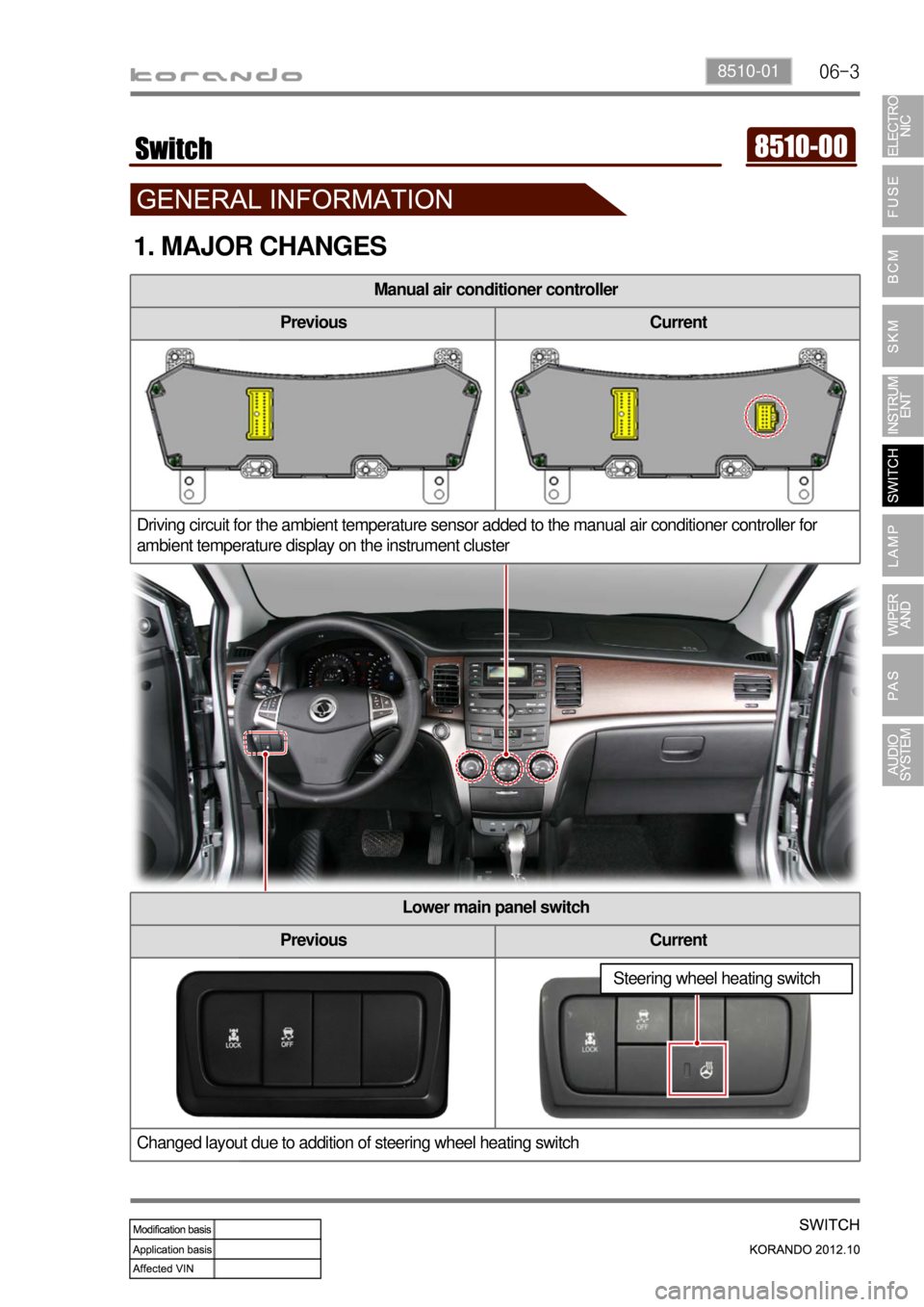
06-38510-01
1. MAJOR CHANGES
Manual air conditioner controller
Previous Current
Driving circuit for the ambient temperature sensor added to the manual air conditioner controller for
ambient temperature display on the instrument cluster
Lower main panel switch
Previous Current
Changed layout due to addition of steering wheel heating switch
Steering wheel heating switch
Page 730 of 1082
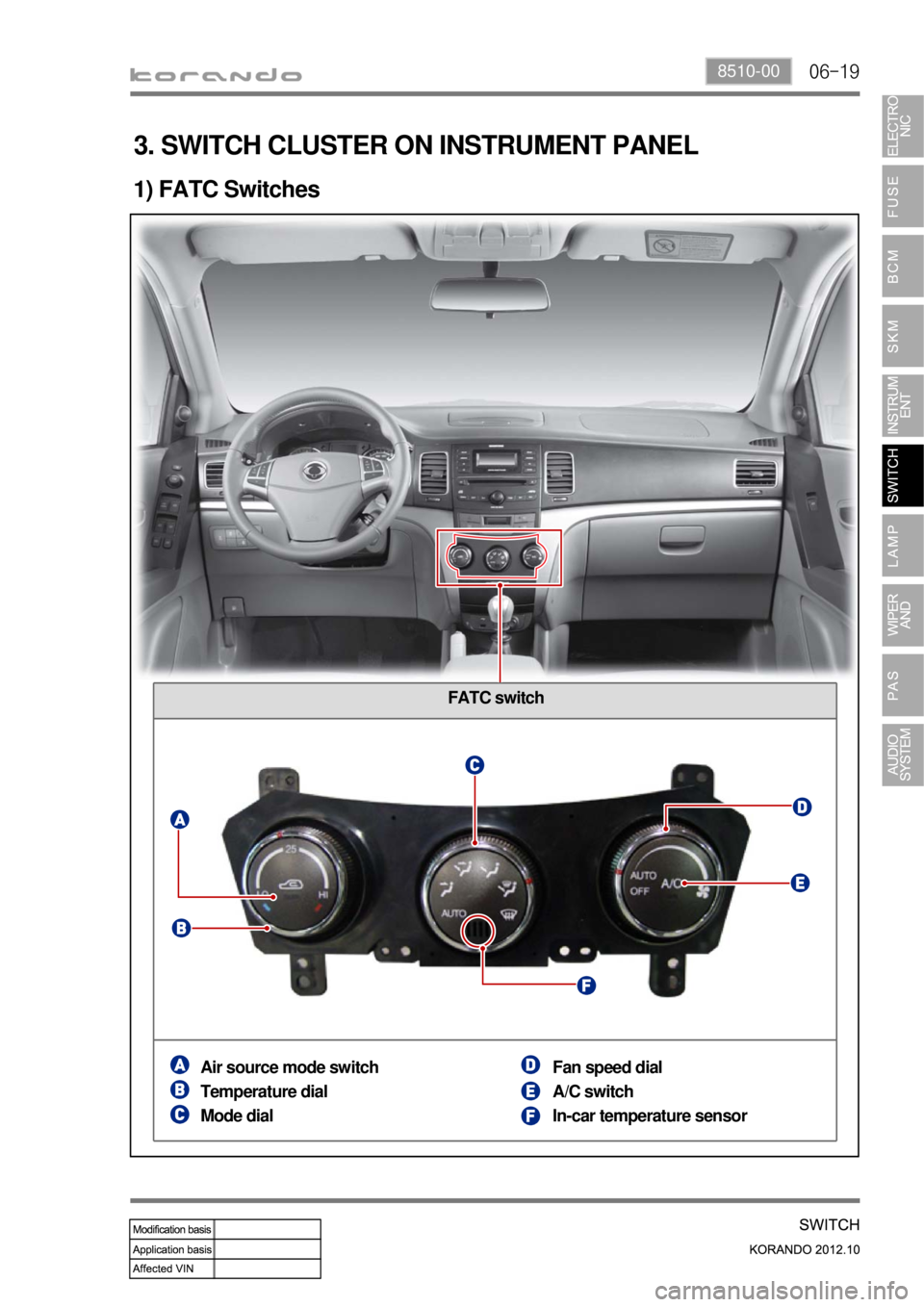
06-198510-00
FATC switch
1) FATC Switches
Air source mode switch
Temperature dial
Mode dialFan speed dial
A/C switch
In-car temperature sensor
3. SWITCH CLUSTER ON INSTRUMENT PANEL
Page 736 of 1082

06-258510-00
SVC class instrument cluster
TRIP A TRIP B
(3) Trip switch
Whenever pressing this button, the information is displayed in the following order: Odometer, Trip A, Trip
B, Distance to empty, Average fuel consumption, Instant fuel consumption, Illumination level, Ambient air
temperature (for STD); Trip A, Trip B, Distance to empty, Average fuel consumption, Instant fuel
consumption, Illumination level, Ambient air temperature (for SVC). Press and hold (for more than 1 sec)
this button to initialize (reset) Trip A/Trip B and average fuel consumption, adjust illumination level or
change the unit of temperature.
Description ▶
The factory setting is DTE mode. ※ Display
Mode
SwitchDetecting
timeFunction
Briefly
and holdBelow 1
second
(60 to
980 ms)STD- Mode change
(Odo→Trip A→Trip B→DTE
<00470047004702e70068009d008c00990088008e008c0047008d009c008c00930047008a00960095009a009c00940097009b00900096009502e700700095009a009b00880095009b0047008d009c008c00930047008a00960095009a009c00940097009b00
9000960095>
→Illumination level→Ambient air temperature)
SVC- Mode change
(Trip A→Trip B→DTE→Average fuel consumption
→Instant fuel consumption→Illumination level
→Ambient air temperature)
Press
and holdOver 1
seconds- Reset
(Trip A, B, average fuel consumption)
- Change
<004700470047004f007000930093009c0094009000950088009b00900096009500470093008c009d008c00930047004f005d0047009b009600470058005000530047009b008c00940097008c00990088009b009c0099008c0047009c00950090009b004700
4f0b4502e90d9100500050>
Not
pressOver 3
seconds- Mode change
<004700470047004f007000930093009c0094009000950088009b00900096009500470093008c009d008c009302e70068009400890090008c0095009b00470088009000990047009b008c00940097008c00990088009b009c0099008c02e70076008b009600
50>
STD class instrument cluster
TRIP A TRIP B
Page 743 of 1082
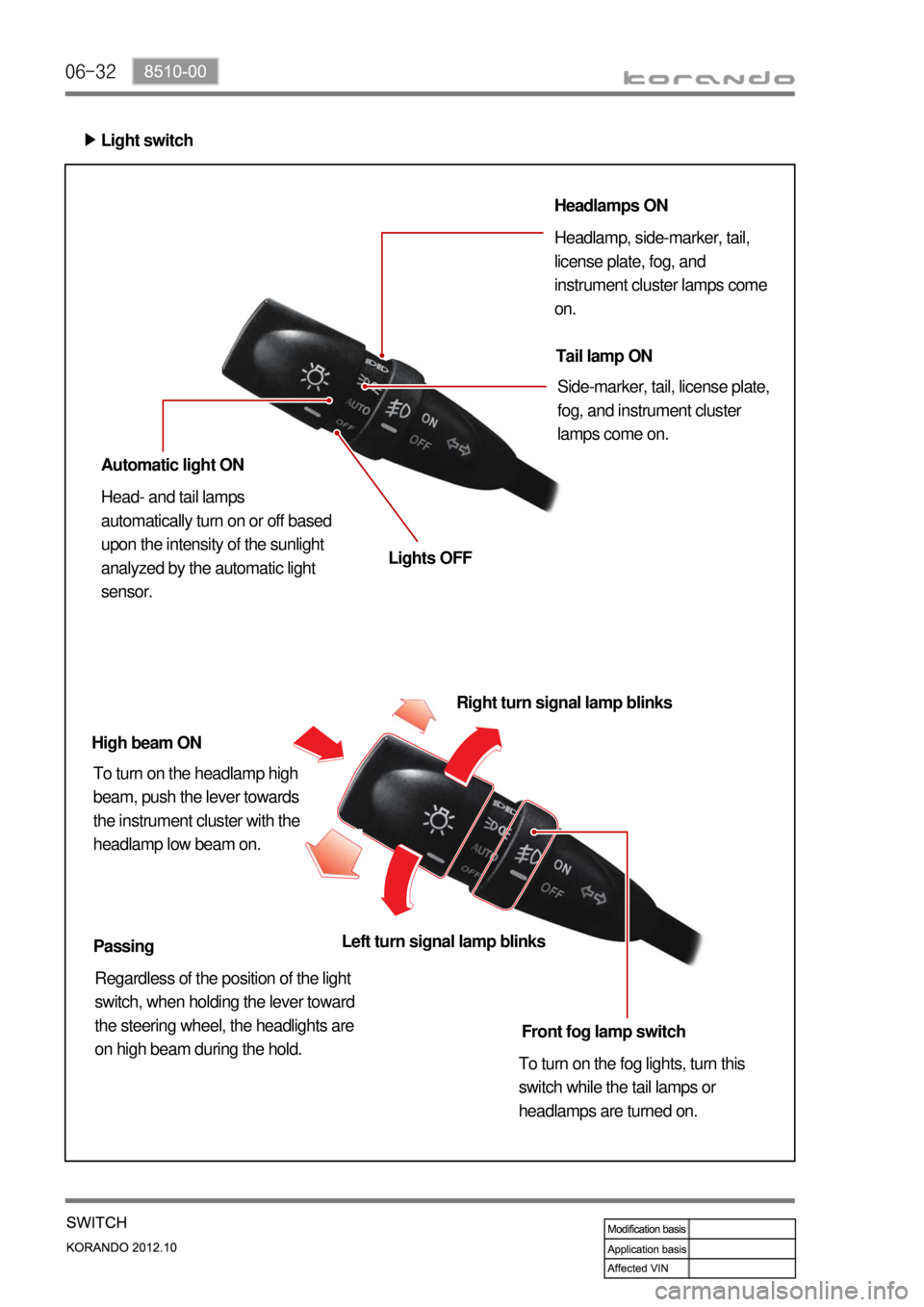
06-32
Light switch ▶
Headlamps ON
Headlamp, side-marker, tail,
license plate, fog, and
instrument cluster lamps come
on.
Tail lamp ON
Side-marker, tail, license plate,
fog, and instrument cluster
lamps come on.
Automatic light ON
Head- and tail lamps
automatically turn on or off based
upon the intensity of the sunlight
analyzed by the automatic light
sensor.Lights OFF
High beam ON
To turn on the headlamp high
beam, push the lever towards
the instrument cluster with the
headlamp low beam on.Right turn signal lamp blinks
Passing
Regardless of the position of the light
switch, when holding the lever toward
the steering wheel, the headlights are
on high beam during the hold.Front fog lamp switch
To turn on the fog lights, turn this
switch while the tail lamps or
headlamps are turned on. Left turn signal lamp blinks
Page 746 of 1082
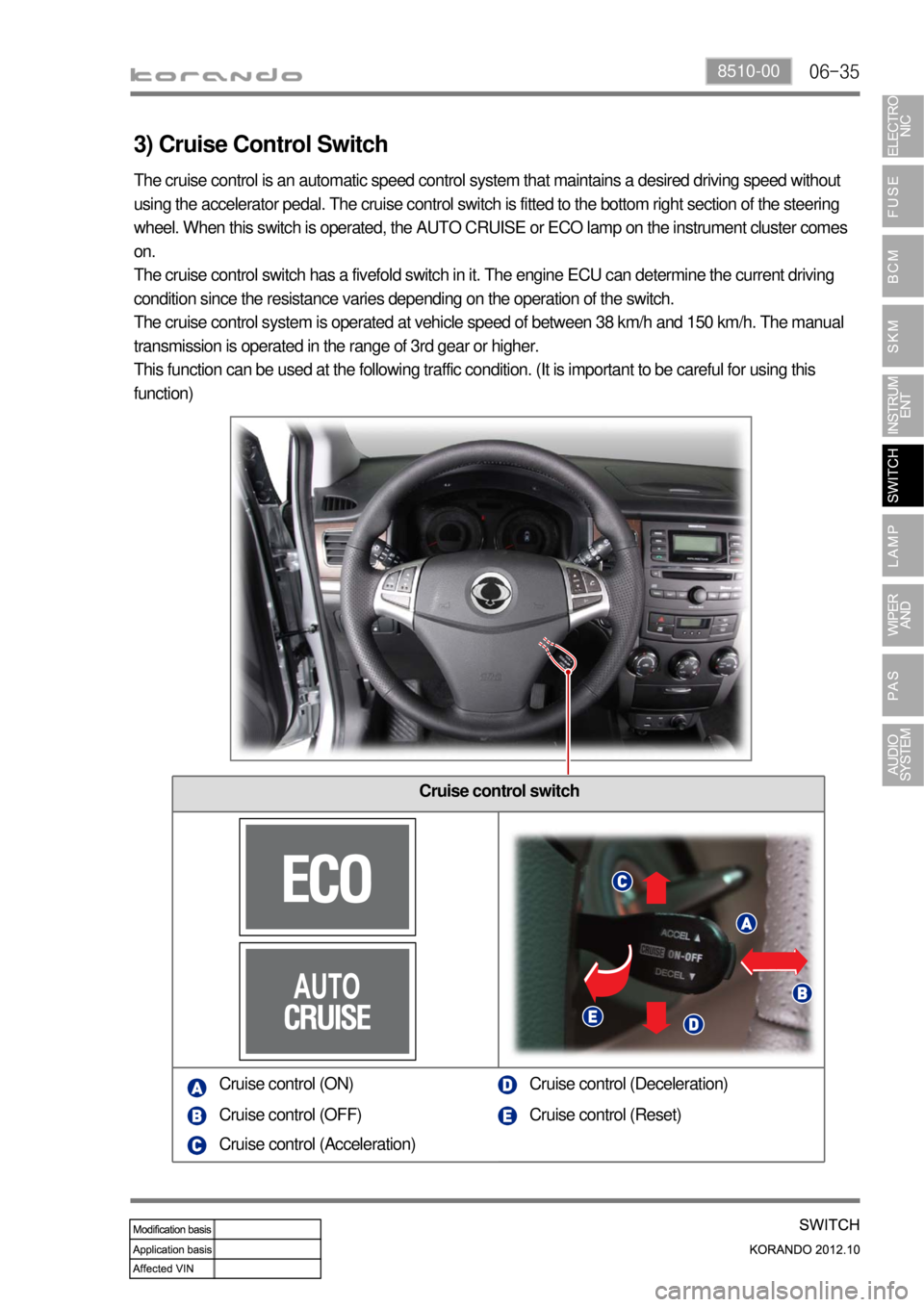
06-358510-00
3) Cruise Control Switch
Cruise control switch
The cruise control is an automatic speed control system that maintains a desired driving speed without
using the accelerator pedal. The cruise control switch is fitted to the bottom right section of the steering
wheel. When this switch is operated, the AUTO CRUISE or ECO lamp on the instrument cluster comes
on.
The cruise control switch has a fivefold switch in it. The engine ECU can determine the current driving
condition since the resistance varies depending on the operation of the switch.
The cruise control system is operated at vehicle speed of between 38 km/h and 150 km/h. The manual
transmission is operated in the range of 3rd gear or higher.
This function can be used at the following traffic condition. (It is important to be careful for using this
function)
Cruise control (ON)
Cruise control (OFF)
Cruise control (Acceleration)Cruise control (Deceleration)
Cruise control (Reset)
Page 793 of 1082
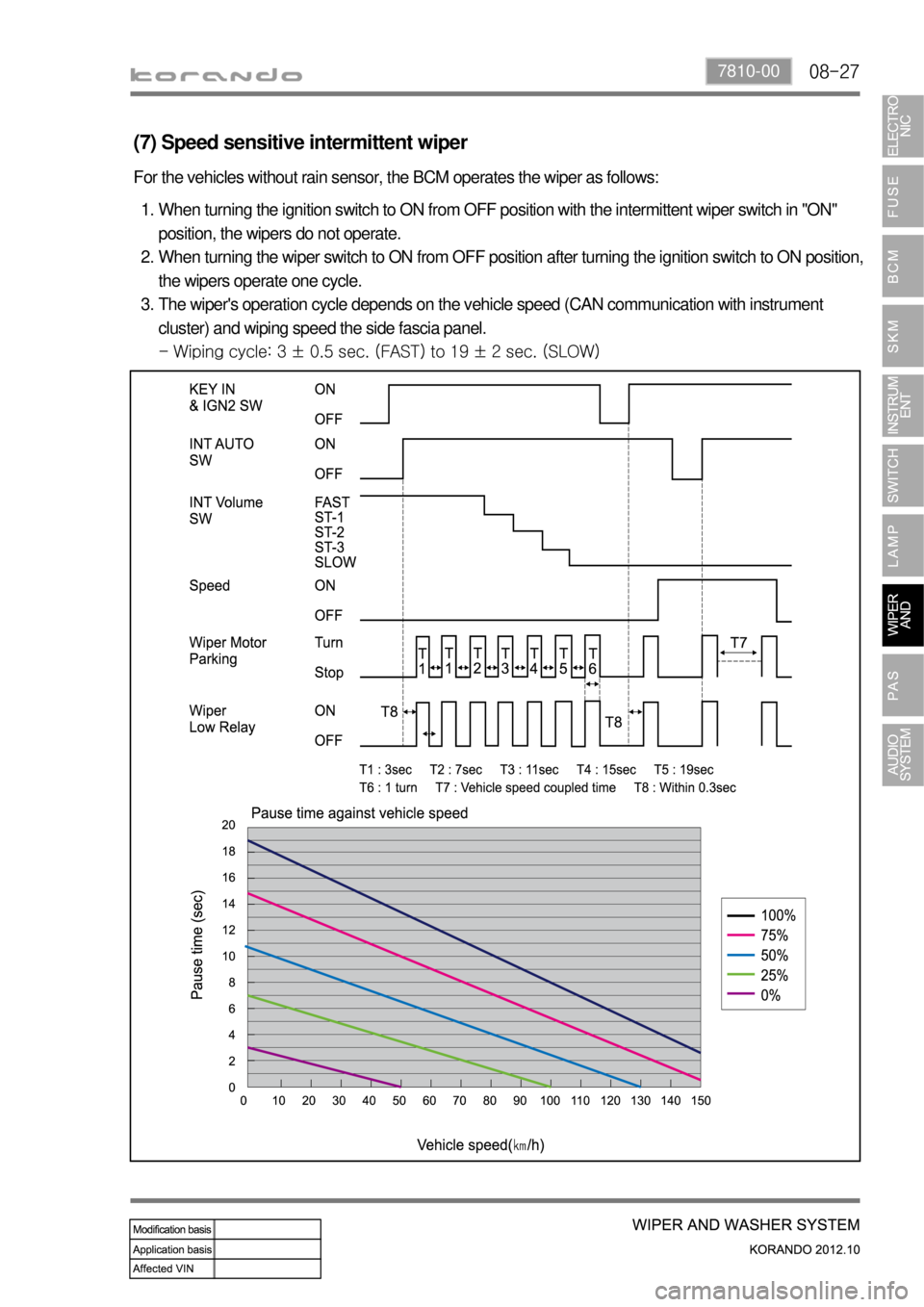
08-277810-00
For the vehicles without rain sensor, the BCM operates the wiper as follows:
When turning the ignition switch to ON from OFF position with the intermittent wiper switch in "ON"
position, the wipers do not operate.
When turning the wiper switch to ON from OFF position after turning the ignition switch to ON position,
the wipers operate one cycle.
The wiper's operation cycle depends on the vehicle speed (CAN communication with instrument
cluster) and wiping speed the side fascia panel.
<00540047007e0090009700900095008e0047008a00a0008a0093008c00610047005a004700b7004700570055005c0047009a008c008a00550047004f006d0068007a007b00500047009b0096004700580060004700b7004700590047009a008c008a005500
47004f007a00730076007e0050> 1.
2.
3.
(7) Speed sensitive intermittent wiper
Page 798 of 1082
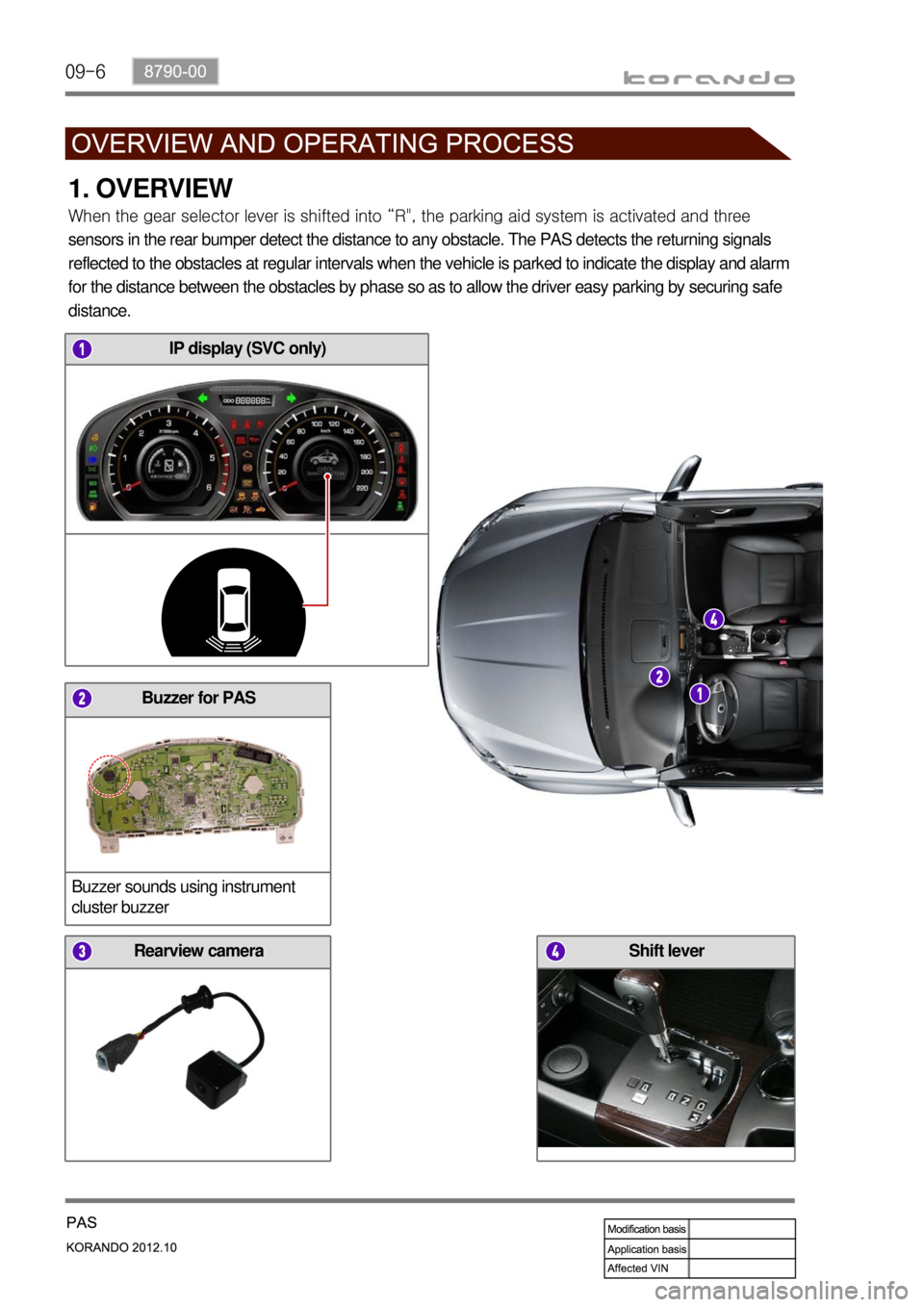
09-6
IP display (SVC only)
When the gear selector lever is shifted into “R", the parking aid system is activated and three
sensors in the rear bumper detect the distance to any obstacle. The PAS detects the returning signals
reflected to the obstacles at regular intervals when the vehicle is parked to indicate the display and alarm
for the distance between the obstacles by phase so as to allow the driver easy parking by securing safe
distance.
1. OVERVIEW
Buzzer for PAS
Buzzer sounds using instrument
cluster buzzer
Rearview cameraShift lever
Page 819 of 1082
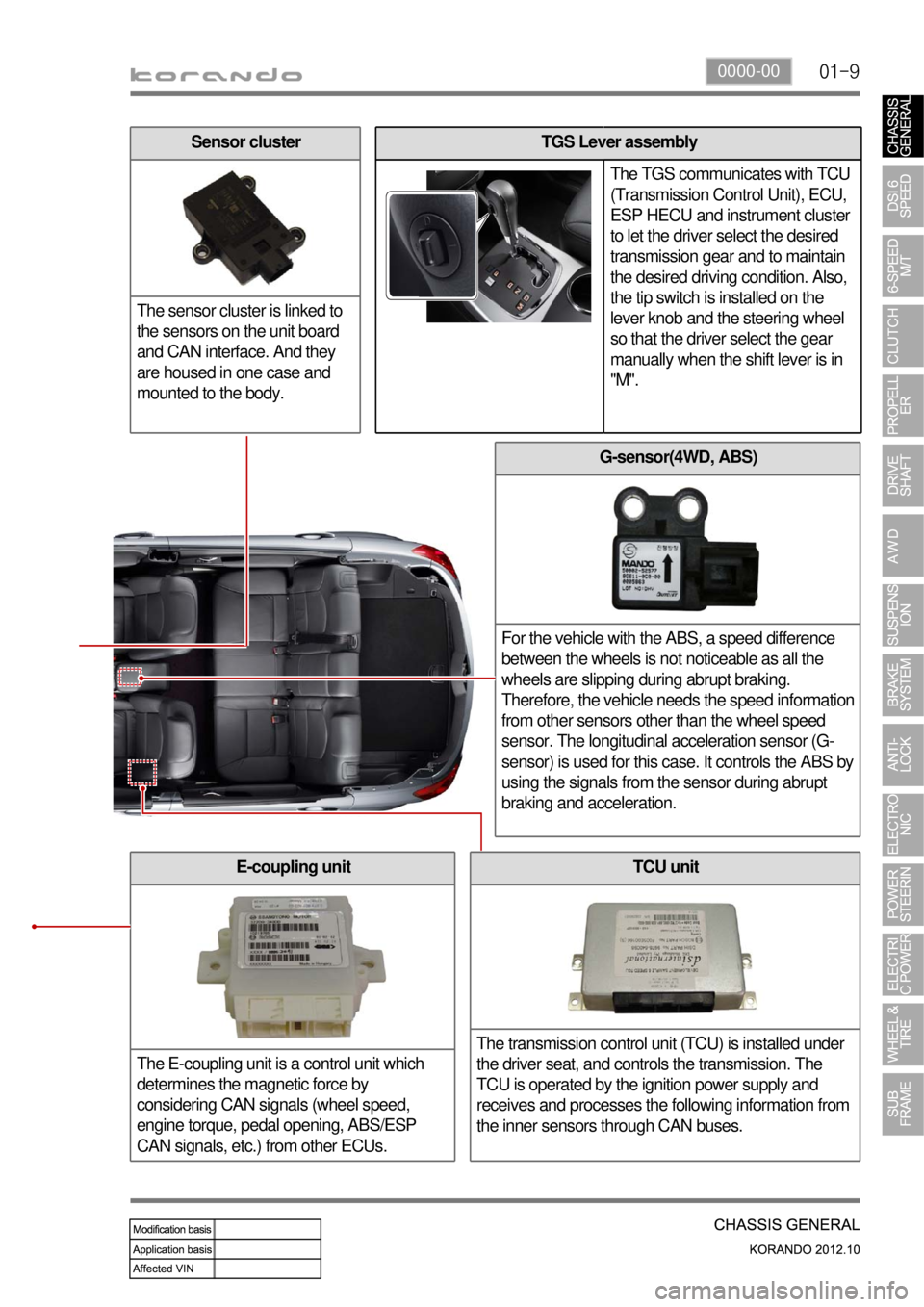
01-90000-00
G-sensor(4WD, ABS)
For the vehicle with the ABS, a speed difference
between the wheels is not noticeable as all the
wheels are slipping during abrupt braking.
Therefore, the vehicle needs the speed information
from other sensors other than the wheel speed
sensor. The longitudinal acceleration sensor (G-
sensor) is used for this case. It controls the ABS by
using the signals from the sensor during abrupt
braking and acceleration.
TCU unit
The transmission control unit (TCU) is installed under
the driver seat, and controls the transmission. The
TCU is operated by the ignition power supply and
receives and processes the following information from
the inner sensors through CAN buses.E-coupling unit
The E-coupling unit is a control unit which
determines the magnetic force by
considering CAN signals (wheel speed,
engine torque, pedal opening, ABS/ESP
CAN signals, etc.) from other ECUs.
TGS Lever assembly
The TGS communicates with TCU
(Transmission Control Unit), ECU,
ESP HECU and instrument cluster
to let the driver select the desired
transmission gear and to maintain
the desired driving condition. Also,
the tip switch is installed on the
lever knob and the steering wheel
so that the driver select the gear
manually when the shift lever is in
"M".Sensor cluster
The sensor cluster is linked to
the sensors on the unit board
and CAN interface. And they
are housed in one case and
mounted to the body.